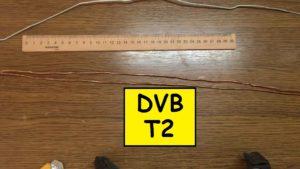
With the transition of television broadcasting to the DVB-T2 digital format, we have noticeably increased the number of channels, and the picture quality is pleasantly pleasing. For many users, the transition went pretty smoothly: they bought a set-top box, connected an old antenna and started using it.
However, some users experienced difficulties with high-quality reception. The reason for this is the antenna.
To make an antenna for receiving digital T2 format, you can use the proposed scheme. Surely many readers have already made a similar design and will confirm that it is assembled simply and quickly. And the reception quality is excellent.
So, you will need the following materials:
- Wire 1.2m . Copper or aluminum with a section of 4 or 6 mm2. (preferably copper - you can make solder joints)
- TV cable
- Thermal gun and one glue stick.
- Lid from a 5 (6) liter water bottle (optional)
- Insulating tape or ties (clamps)
Bend the wire into a square shape. The length of each side is 13 cm. At the edges, leave a margin of 1-1.5 cm for fasteners. You need to make two such squares.
At this stage of installation, you can already test the capabilities of your antenna. Connect the antenna cable to the attachment points, according to the photo below: the central core to the top point, the screen braid to the bottom. The distance between connection points is 11mm.
If the antenna is located on the street, it is better to refuse a bolted connection. Over time, the copper will oxidize and the bolts will rust. The contact will deteriorate and this will not affect the quality of the “picture” in the best way. And over time, in general, the wire can fall off.
Therefore, it is better to get confused a little more and make the connection of the antenna to the cable soldered.
In addition, the connection node can be permanently sealed. To do this, use the lid from a 5 (6) liter water container. Having previously cut through the windows to accommodate the antenna wires, the assembly is placed in the lid and filled with adhesive from a thermal gun. If you don't have a heat gun, you can fill it with any other glue, but in this case you will have to wait a few hours until it dries.
You can not bother with the lid at all, but simply fill the assembly with adhesive from a thermal gun.
The antenna should be placed vertically, as in the photo below. Therefore, the television cable must be carefully taken down. It can be fixed to the wire of the antenna itself with electrical tape or ties (clamps).
For more information about the antenna design process, you can watch the video: